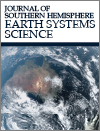Journal of Southern Hemisphere Earth Systems Science
Volume 73
Number 2 2023
A summary of the southern hemisphere atmospheric circulation patterns and meteorological indices for summer 2019–20. Conditions were extreme across the southern hemisphere, with notable drought conditions persisting from spring over large parts of South America. Unprecedented extremes for Australia included many heat and fire weather extremes. Temperature anomalies for land and ocean areas of the southern hemisphere were third and second highest respectively on record.
Clouds from volcanic eruptions that reach the upper troposphere and stratosphere can create significant aviation hazards on periods of days to weeks and possibly affect the global climate for up to a year or longer. A key variable for understanding and forecasting these effects is the height that the volcanic cloud reaches, which is often difficult to estimate. This work refines existing techniques to create a straightforward method that accurately estimates the height of these eruptions.
Coastal floods are known to become increasingly frequent as sea-level rise increases the height around which daily tides rise and fall. In this study, we find that changes in the heights of tides that have led to much more frequent flooding in Lakes Entrance than would expected due to sea level rise alone. The first study of its kind for Australia, this research highlights the need for further work on defining impact-based thresholds and understanding how tides and other drivers of sea level change (other than sea-level rise) are changing flood hazards.
South-west Western Australia (SWWA) significantly contributes to Western Australia’s economy through its weather-dependent grains industry. This study evaluated rainfall forecasts for the wheat growing season in SWWA from the Australian Bureau of Meteorology’s seasonal forecasting model (ACCESS-S1) by comparing past forecasts with observations. Results showed shortcomings in the model’s growing-season forecasts of SWWA rainfall. Errors were identified in simulation of Indian Ocean sea surface temperatures and timing of heavy rainfall events, likely causing the forecast limitations. These findings will inform future model development.
Water vapour plays a key role in the global hydrological cycle given its link to the formation of clouds and precipitation. An analysis of homogenised all-Australian dew point temperature series over the 1965–2017 period indicates an increase of moisture content at the 850–400-hPa levels. This increase in the lower and middle troposphere is in accordance with the expectation that, as the troposphere warms, the amount of moisture in it should increase.
The climate is changing, and precipitation shows this. Studying the concentration of precipitation (i.e. its distribution over time) helps us to understand one of the implications of climate change. The variability of the precipitation concentration index shows the irregular distribution of precipitation on a spatial scale. The trends show less precipitation and more irregular distribution. Studies of the concentration of precipitation are a useful tool for water resources management plans (urban flood management and runoff collecting systems).
This paper presents an analysis of the South Australian severe thunderstorm and tornado outbreak of 28 September 2016, which produced at least seven tornadoes and contributed to a state-wide power outage. By analysing high-resolution simulations, we aim to offer a better understanding of meteorology of this event. The study shows the importance of running multiple simulations (ensembles) to provide a range of possible outcomes (as opposed to a single forecast), helping forecasters predict the likelihood of tornadic outbreaks more accurately.
Channelling of the valley winds in the Hunter Valley, New South Wales, has significant influence on the weather in the region. In particular, the amplification of the westerly winds by valley channelling in the region is known as ‘Hunter funnelling’. In this paper, the prevalent channelling mechanisms in the Hunter Valley in winter and summer, and a conceptual model of the topographic enhancement of westerly winds through the Hunter Valley (‘Hunter Funnelling’) are discussed. This should be of particular interest to the operational forecasters, emergency service personnel, and the general public.
The prediction of concentration and distribution of PM2.5 parameters during forest fires is important. Predicting PM2.5 can use the WRF–Chem model with the old version of FINN data input, but it still does not produce accurate results. The latest FINN data have been released and can be used to update the old FINN data.




